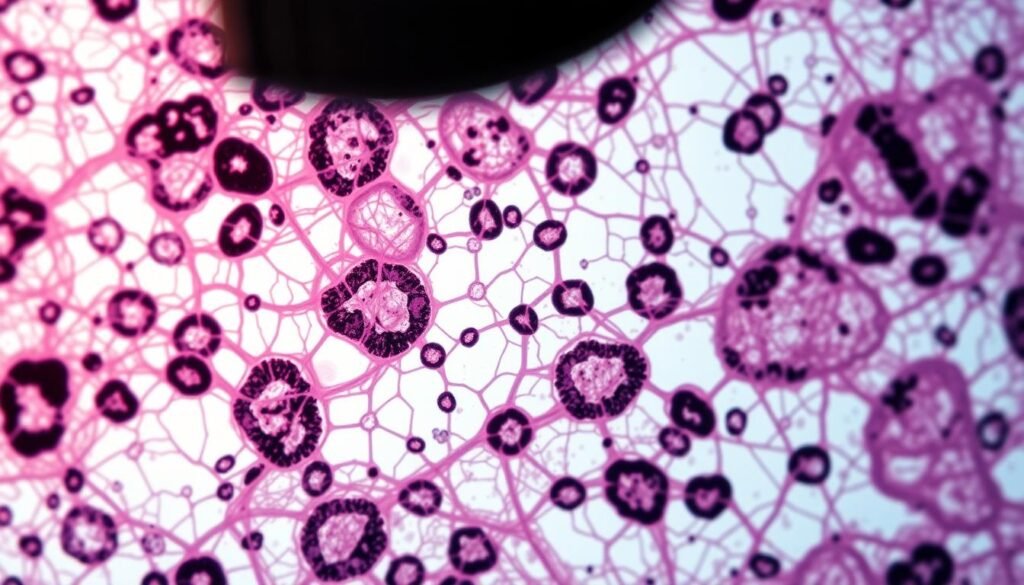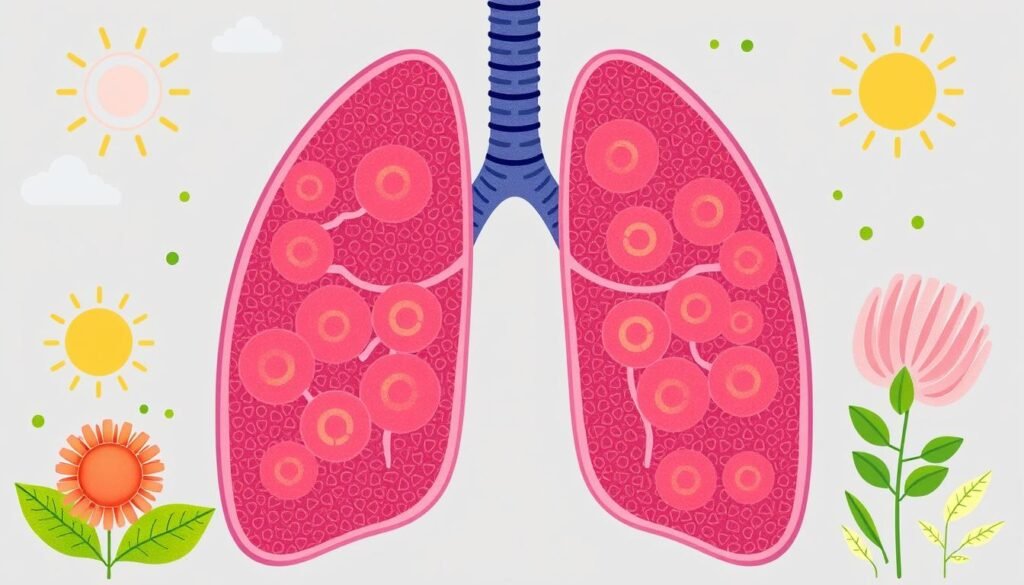In 2023, lung cancer was the top cause of cancer deaths in the US. It led to about 127,070 deaths. Squamous cell carcinoma (SCC) of the lung is a major type. It makes up about 30% of non-small cell lung cancers (NSCLCs). Most cases, nearly 80% in men and 90% in women, are linked to smoking. Knowing about this cancer, how it grows, and treatment options can help save lives.
SCC has a complex way of developing and being found. Doctors often use CT scans to detect it. By catching it early and spreading awareness, we can fight this tough disease. Let’s learn more about squamous cell carcinoma. We’ll see how it affects health and what treatments are available.
Key Takeaways
- Squamous cell carcinoma accounts for about 30% of non-small cell lung cancers.
- Smoking is responsible for 80% of lung cancer cases in men and 90% in women.
- Lung cancer was linked to an estimated 127,070 deaths in the U.S. in 2023.
- CT scans are commonly used for initial diagnosis of squamous cell carcinoma.
- Though treatment options exist, many cases are diagnosed only after metastasis.
- Approximately 40% of non-small cell lung cancer cases have already spread by diagnosis.
What is Squamous Cell Carcinoma?
Squamous cell carcinoma (SCC) is a major type of lung cancer. It makes up about 30% of all non-small cell lung cancer (NSCLC) cases. It starts in the squamous cells that cover the airways in the lungs. SCC often grows in the lungs’ central areas, highlighting the need for early detection and treatment.
This lung cancer, also known as epidermoid carcinoma, is strongly connected to smoking. NSCLC, which includes SCC, accounts for 80% to 85% of all lung cancers. This shows how vital it is to know about different lung cancer types. Adenocarcinoma, another NSCLC variant, is usually found in non-smokers.
When doctors look at squamous cell carcinoma under a microscope, it has a unique look. The squamous cells are flat and thin. This specific appearance helps doctors plan the best treatment based on the cancer’s distinct features.
Keeping an eye on squamous cell carcinoma’s traits is key to managing it effectively. Smokers especially need to be proactive. Early screening can help lower the risks that come with this serious disease.
| Type of Lung Cancer | Percentage of Cases | Association with Smoking |
|---|---|---|
| Non-Small Cell Lung Cancer (NSCLC) | 80% – 85% | High |
| Squamous Cell Carcinoma | 30% | Very High |
| Adenocarcinoma | 50% | Low to Moderate |
| Small Cell Lung Cancer (SCLC) | 10% – 15% | Very High |
| Lung Carcinoid Tumors | Less than 5% | Minimal |
How Squamous Cell Carcinoma Develops in the Lungs
To understand how squamous cell carcinoma starts in the lungs, we need to look at how cells change and the role of carcinogens. Tobacco smoke is a major player in this type of cancer. It turns normal cells into cancerous ones.
Cellular Transformation Processes
Normal squamous cells in the lungs change into cancer cells through a series of mutations. These changes come from exposure to harmful substances. The journey towards developing a lung tumor involves several key steps:
- High mutation frequency in the DNA of lung cells.
- Keratinization within tumor cells, showing changes in how the cells look and work.
- Progression through different stages of cancer, from stage 0 to stage IV.
The Role of Tobacco Smoke
Tobacco smoke is packed with over 300 dangerous substances that play a big role in developing squamous cell carcinoma in the lungs. The link between smoking and lung cancer is clear:
- About 30% of all lung cancers are squamous cell lung cancer.
- This type of cancer is much more common in smokers than other kinds.
- It is very rare for non-smokers to get squamous cell carcinoma.
The harmful substances in tobacco smoke can cause cancer to spread to other parts of the body. This is why finding and preventing it early is key to handling the disease.
Epidemiology of Lung Cancer
Lung cancer is a big health issue around the world. It leads to many deaths from cancer. Knowing the statistics on incidence and mortality helps us fight this health problem. In the U.S., around 238,340 new lung cancer cases are expected in 2023. This is about 12% of all cancer cases.
Statistics on Incidence and Mortality
Lung cancer greatly affects society. The National Cancer Institute’s SEER database shares important facts:
- In 2010, about 239,320 new lung cancer cases were reported in the U.S., leading to 161,250 deaths.
- Worldwide, lung cancer caused 1,350,000 new cases and 1,180,000 deaths. This shows it’s a top cause of cancer death.
- In the U.S., men had an incidence rate of 75.2 per 100,000, while women had 52.3.
- Lung cancer is responsible for 28% of all cancer deaths in men and 26% in women.
- The 5-year survival rate is now 15.6%, highlighting the importance of early detection.
Demographics Affected
The demographics affected by lung cancer show a clear trend. Most people are diagnosed at age 71. No one under 20 has been diagnosed. There have been changes in lung cancer rates among different groups:
| Gender | New Cases (2023) | Estimated Deaths | Incidence Rate (per 100,000) |
|---|---|---|---|
| Men | 115,060 | 85,600 | 75.2 |
| Women | 106,070 | 71,340 | 52.3 |
Lately, lung cancer rates in women have gone down. Men’s death rates from lung cancer have dropped by 2% each year. There’s a strong link between smoking and lung cancer. Genetic factors also play a role for some people.
Risk Factors for Squamous Cell Carcinoma
Understanding squamous cell carcinoma’s risk factors helps with prevention and early detection. These include lifestyle choices, environmental exposures, and genetic factors. Together, they greatly affect the chance of developing this type of lung cancer.
Impact of Smoking
Smoking is the biggest risk factor for squamous cell carcinoma. Around 80% of lung cancer deaths are linked to smoking. The risk increases with the amount smoked and how long the habit lasts. Secondhand smoke is also a major concern. It’s the third leading cause of lung cancer in the U.S., posing risks to those often exposed.
Other Environmental Exposures
Some environmental factors also raise the risk of squamous cell carcinoma. Exposure to asbestos and radon, for example, can make lung cancer much more likely. Radon is even the top cause of lung cancer for non-smokers. Work-related dangers like arsenic, radiation, and other carcinogens add to the risk.
Genetic Predisposition
A family history of lung cancer can make someone more likely to get squamous cell carcinoma. Certain skin conditions increase this vulnerability. For example, xeroderma pigmentosum and albinism make skin extra sensitive to the sun. This leads to a higher chance of getting skin and lung cancers. Knowing these genetic risks is key for high-risk individuals.

| Risk Factor | Description |
|---|---|
| Smoking | Major contributor to lung cancer risk, accounting for approximately 80% of deaths. |
| Secondhand Smoke | Increases lung cancer risk for non-smokers significantly exposed to tobacco smoke. |
| Radon Exposure | Leading cause of lung cancer among non-smokers, often found in homes. |
| Asbestos | Occupational exposure increases lung cancer risk, especially for smokers. |
| Genetic Factors | Family history and certain genetic conditions heighten vulnerability. |
Symptoms of Squamous Cell Carcinoma
Knowing the symptoms of squamous cell carcinoma helps catch it early. Early symptoms often include a non-stop cough, chest pain, and breathing problems. Fatigue and losing weight without trying are also common. These early signs affect daily life and happiness.
Common Clinical Symptoms
Key symptoms to watch out for include:
- Coughing, especially if it gets worse over time.
- Coughing up blood or mucus, which needs fast medical help.
- Chest pain, constant or on and off, worsened by deep breaths or coughing.
- Shortness of breath, showing the cancer might be hurting lung function.
- Hoarseness in the voice from airway impact.
- Fatigue that rest doesn’t help.
- Decreased appetite leading to weight loss.
Advanced Symptoms Indicating Metastasis
When the cancer spreads, it shows more severe symptoms. Advanced signs include:
- Bone pain from cancer in the bones.
- Neurological symptoms like headaches, seizures, or mental changes, suggesting brain involvement.
- Compression syndromes from tumors pressing on nearby areas.
Spotting these advanced signs is critical for getting the right treatment. Catching squamous cell carcinoma symptoms early helps in treating it effectively. To learn more about this cancer, visit this resource.
Diagnosis of Squamous Cell Carcinoma
To diagnose squamous cell carcinoma, doctors first do imaging studies like chest X-rays and CT scans. These scans are key for finding the tumor’s size and place. After finding areas that look suspicious, doctors move to histological examination to confirm it’s cancer.
Imaging Studies
Imaging studies play a big role in checking for lung cancer, especially for those with symptoms. CT scans provide detailed images of the lungs, spotting changes that might mean squamous cell carcinoma is there. With X-rays added, doctors can get a better look at the lung’s status before using more invasive ways to diagnose.
Histological Examination
Histological techniques are used after imaging suggests cancer might be present. By looking at biopsy samples through a microscope, doctors can see squamous cell carcinoma’s specific traits. Finding features like keratinization and intercellular bridges is crucial for a correct diagnosis. This step is important for making the right treatment plan.
Biopsies and Other Diagnostic Techniques
Different biopsies are done to be sure it’s squamous cell carcinoma. For instance, bronchoscopy involves using a thin tube to get lung tissue. Other methods, like PET scans, help see how far the cancer has spread. This thorough process of diagnosis makes sure patients get the care they need quickly. For more details, click here.

| Diagnostic Method | Purpose | Details |
|---|---|---|
| Imaging Studies | Identify tumor presence | Includes chest X-rays and CT scans |
| Histological Examination | Confirm diagnosis | Analyzes biopsy samples for specific cancer indicators |
| Biopsies | Collect tissue samples | May include bronchoscopy for lung tissue |
| PET Scans | Assess disease extent | Help identify metastasis |
Treatment Options Available
Treatment for lung squamous cell carcinoma involves many steps. It often combines surgery, chemotherapy, and new immunotherapy options. Each method is vital for fighting this aggressive cancer.
Surgical Interventions
Surgery is usually the starting point against squamous cell carcinoma. The surgeries can include:
- Lobectomy – Removing a lung lobe.
- Pneumonectomy – Taking out an entire lung.
- Wedge resection and segmental resection – Cutting out a small lung piece.
These surgeries aim to remove tumors and save as much lung as possible. The surgery type depends on tumor size, location, and patient health.
Chemotherapy Regimens
Chemotherapy is key, especially after surgery. Treatment plans are tailored to the cancer stage and past treatment results. Often used drugs are:
- Cisplatin
- Carboplatin
- Pemetrexed
This treatment kills remaining cancer cells. It often pairs with other therapies.
Immunotherapy and Targeted Therapy
Immunotherapy is a new treatment, boosting the immune system to fight cancer. It’s used after surgery or if surgery isn’t possible. It has helped patients live longer.
Targeted therapy focuses on cancer’s genetic changes. It stops cancer growth by hitting specific weak spots. For more on immunotherapy, see this detailed guide.
Prognosis and Survival Rates
The outlook for people with squamous cell carcinoma depends on many factors. These include the cancer’s stage when found, the patient’s overall health, and specific tumor traits. Finding the cancer early is key to a better survival chance. Knowing about these aspects helps doctors create the best care and treatment plans.
Factors Influencing Prognosis
If squamous cell carcinoma is caught at Stage 0, it’s only in the top layer of skin. Here, the five-year survival rate is 99 percent. But, as the cancer grows, survival rates drop. At Stage 4, the cancer has spread far, and fewer than half the patients survive past five years.
- Stage 0: Cancer confined to the epidermis (99% survival rate)
- Stage 1: Deeper into the skin, no lymph node involvement
- Stage 2: Exhibits high-risk features, still localized
- Stage 3: Spread into lymph nodes, localized to body
- Stage 4: Metastasis to at least one distant organ (survival rate
Comparative Survival by Subtype
The survival rates for squamous cell carcinoma can be quite different among its subtypes. This cancer type makes up 25-30% of lung cancers, mainly affecting those who smoke, and is rare in non-smokers. The positive news is, over 80% of patients who get surgery early are still alive after five years. This highlights how crucial early detection and treatment are.
| Stage | Description | Estimated 5-Year Survival Rate |
|---|---|---|
| Stage 0 | Confined to epidermis | 99% |
| Stage 1 | Deep into skin, no lymph node spread | High |
| Stage 2 | Localized, presents high-risk features | Moderate |
| Stage 3 | Lymph node involvement, localized disease | Lower than 50% |
| Stage 4 | Metastases to distant organs | Less than 50% |

The Importance of Early Detection
Finding lung cancer early greatly improves the chance of successful treatment. It results in better outcomes for patients. Being aware of the signs for early action can lead to a quick medical check-up. This lets doctors start treatment early. Signs like a constant cough, unexpected weight loss, or feeling short of breath are important. They should make someone consider getting checked out.
Signs for Early Intervention
Knowing the early signs is key in battling lung cancer. These signs include:
- Persistent cough lasting more than three weeks
- Unexplained weight loss
- Chest pain
- Shortness of breath
- Coughing up blood
Paying attention to these signs early can help find the cancer sooner. This increases the chance of treating it successfully. It shows why spotting lung cancer early is so crucial.
Screening Recommendations
The American Cancer Society advises yearly screenings for lung cancer. This is for people 50 to 80 years old who have smoked a lot in the past. This screening focuses on finding lung cancer early in those at higher risk, like long-term smokers. LDCT scans can save lives by finding lung cancer early. But, they might also find things that aren’t cancer. This could mean more tests that aren’t needed.
Screening should happen in places that know how to do LDCT well. This ensures the best results. Medicare and many insurance plans often cover the cost of this screening. This makes it easier for those who qualify to get screened. Choosing to get screened is a decision made together by the patient and their doctor. It’s important in figuring out if lung cancer screening is right. For more on screening guidelines, check this source.
Ongoing Research and Advancements
Today, the battle against squamous cell carcinoma is changing due to new research. Scientists are finding better treatments and discovering biomarkers to improve care. These steps help make treatments more effective for everyone.
Clinical Trials and New Treatments
Right now, clinical trials are testing new ways to fight squamous cell carcinoma. They’re exploring immune therapies and drug combinations. Two exciting drugs, pembrolizumab (Keytruda) and nivolumab (Opdivo), now have FDA approval. They are used after surgery and chemo to fight non-small cell lung cancer.
This progress shows how treatment is becoming more tailored to individual patients. It’s a move towards care that matches each person’s unique cancer.
Role of Biomarkers in Treatment
Biomarkers are becoming key in choosing the right treatment for lung cancer. They help predict how well a treatment will work. Studies have found specific changes in the genes of lung squamous cell carcinoma.
This knowledge helps doctors create personalized treatment plans. Tools like machine learning are making biomarker research even more accurate, with a success rate of 97%. This accuracy is pushing biomarker use in everyday cancer care.
Conclusion
Squamous cell carcinoma of the lungs presents major challenges. It is a common type of lung cancer. In men, it makes up about 30% of cases, and 20% in women.
Learning its signs early is key to improving survival rates. This can have a big impact on patient recovery.
Since 1979, the overall cases have dropped. Yet, there’s been a recent increase. This might be due to better ways of identifying it.
This increase shows why it’s critical to keep researching. Especially how it’s linked to smoking and the environment. We’re seeing new treatments from surgery to specialized drugs. These hold promise for better control of the disease.
Raising awareness and pushing for early detection are crucial. They help fight against the spread of squamous cell carcinoma. With new treatments being researched, spotting the signs early and screening are key. These efforts aim to enhance how we manage care and improve chances of recovery.